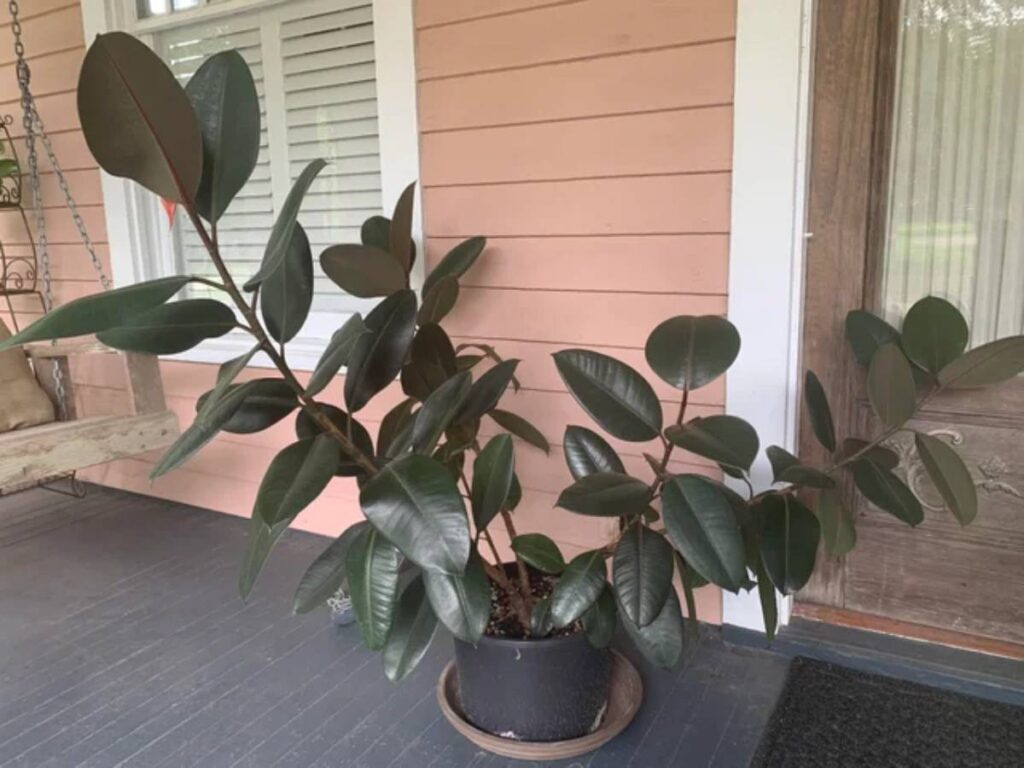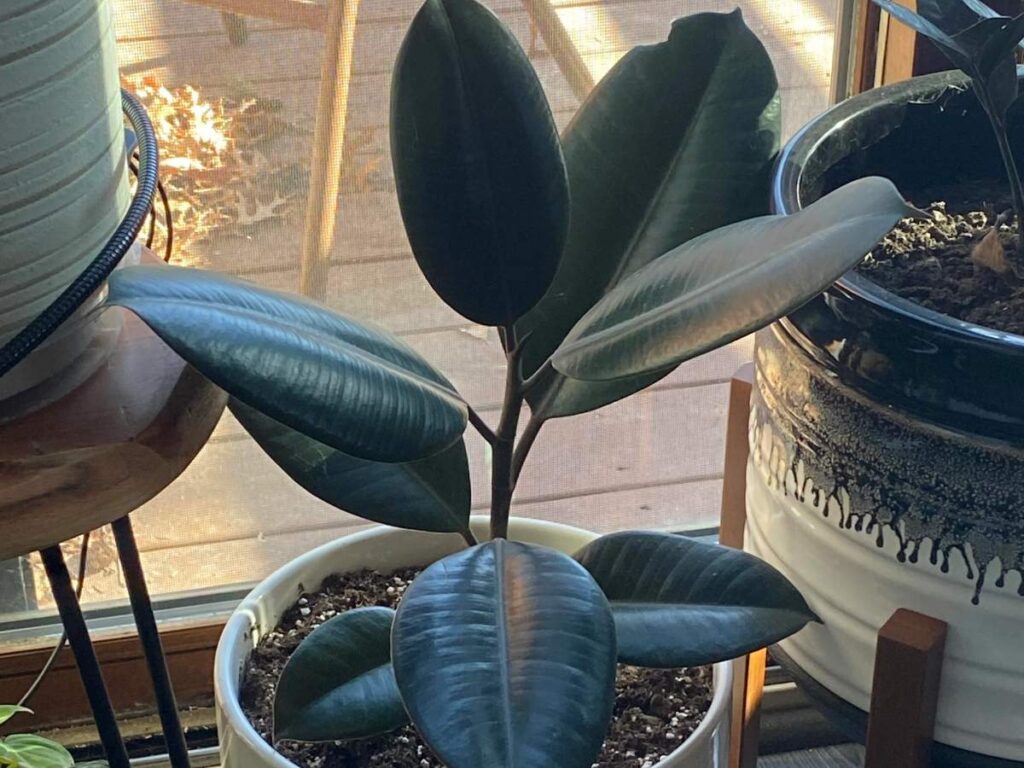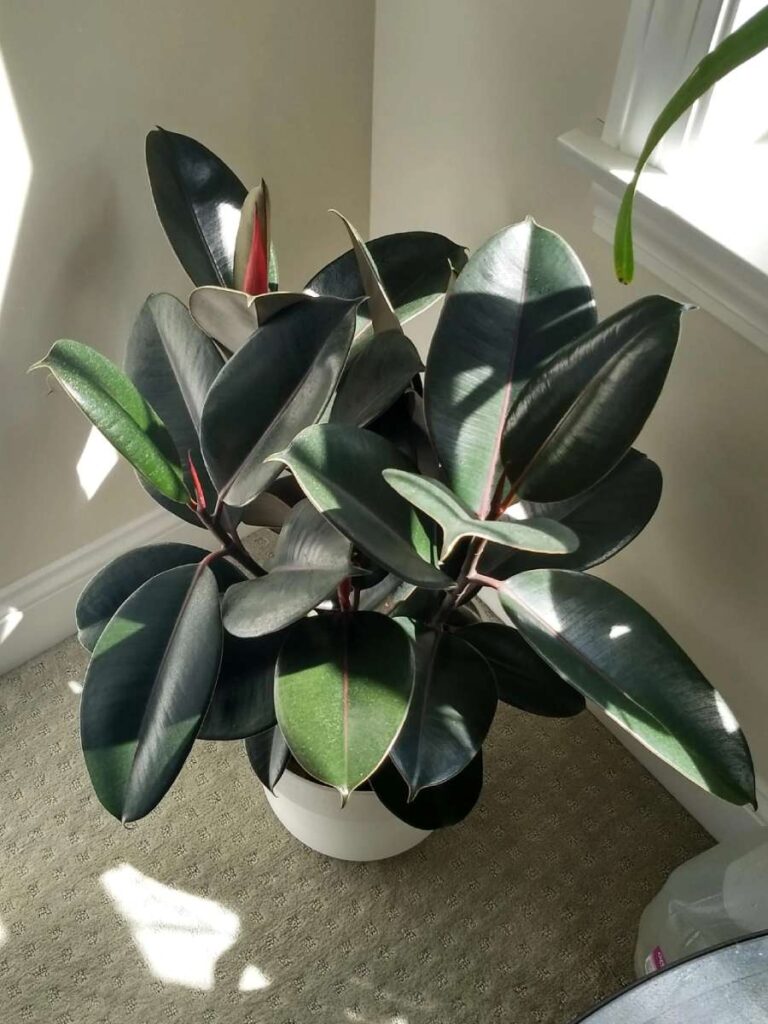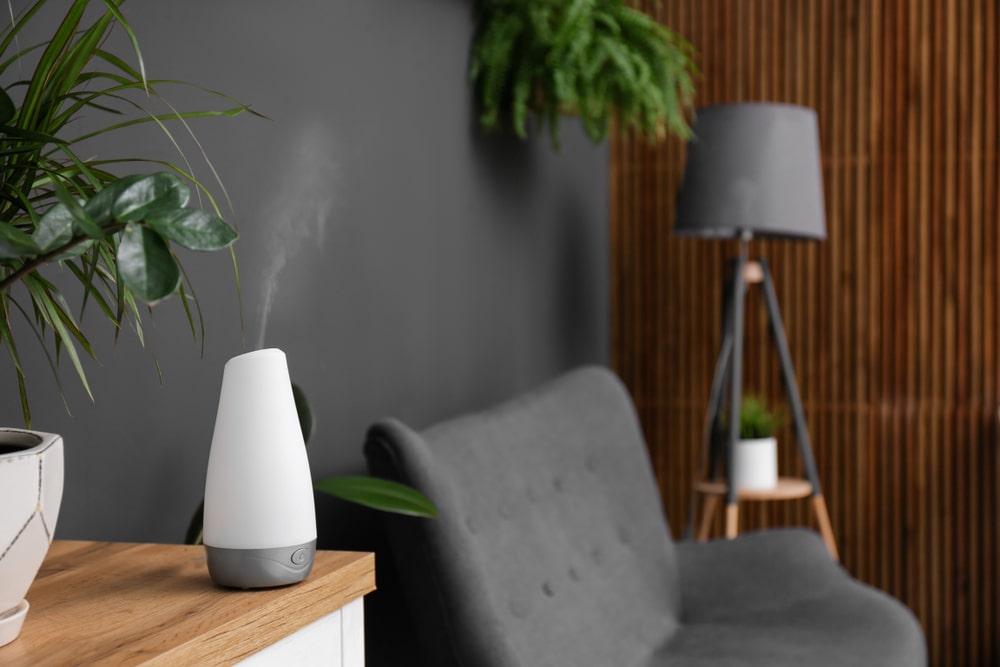Have you ever wanted to own a rubber plant (Ficus Elastica) so severely that the thought of being unable to keep it alive during winter seemed utterly unbearable?
Well, now your worries are over! Believe it or not, these resilient plants can survive even the harshest conditions. I’m here to tell you how and why they can withstand such unforgiving temperatures.
So buckle up and prepare for an exciting journey into surviving winter as a rubber plant!
Here’s Can Rubber Plants Survive Winter?
Rubber plants can survive winter, although they may need some protection. They can tolerate temperatures as low as 50°F but tend to thrive best in warm conditions between 60 and 75°F. Therefore, it may be necessary to provide extra protection for rubber trees kept outdoors during winter.

Signs Of A Rubber Plant Struggling In Winter
It’s no secret that rubber plants are fragile in cold weather. In fact, roughly two-thirds of all houseplants experience damage when temperatures dip below 50°F (10°C).
So, if you’re wondering what signs to look out for to determine if your rubber plant is struggling during the winter, here are a few key things to keep an eye on.
First off, check for any discoloration or wilting leaves. Rubber plants may become more prone to leaf drop and yellowing in colder climates as they don’t have enough humidity or warmth to survive.
It’s also essential to inspect the roots of your rubber plant; if there is root rot present, it can cause significant issues with growth and ultimately lead to the death of the plant itself.
If needed, try wrapping some plastic wrap around the pot base and soil surface – this helps retain moisture while preventing too much water from getting into the soil, which could result in root rot.
Finally, be sure not to overwater your rubber plant because this can create a breeding ground for pests such as fungus gnats which will wreak havoc on your beloved green friend!
To prevent watering, make sure your soil dries out between each session and never let standing water accumulate near its roots – add sand or pebbles at the bottom of pots with drainage holes, so excess water escapes quickly instead of having nowhere else to go but back into the soil where it doesn’t belong!
Caring For A Rubber Plant During Winter
As the winter chill settles in, I’m sure many of us are wondering how to care for our beloved rubber plants. Luckily, we can keep them happy through the cold months with simple tips and tricks!
Firstly, it’s important to remember that while these tropical beauties love humidity, they also need good airflow. So don’t forget to open windows or turn on an air humidifier near your plant during colder days.
In addition, you’ll want to make sure to adjust the temperature between 65°F-80°F as too much heat will cause the leaves of your plant to brown or yellow.
Speaking of browning – another key factor in keeping your rubber plant alive is making sure its soil doesn’t dry out completely between waterings.
To do this, regularly check if there’s any moisture left at the pot’s bottom before adding more water – this way, you won’t oversaturate your poor pal!
Yet no matter what method you use, ensure that excess water drains away properly and isn’t sitting stagnant around the roots – otherwise, root rot could occur.
It may take some extra effort, but by ensuring these basic measures are taken into account when caring for your rubber plant during wintertime, you can rest assured that come spring, it’ll be ready once again to bring color and joy into your home.

Temperature Requirements For A Rubber Plant In Winter
When it comes to temperature, a rubber tree is sensitive. It doesn’t like drastic changes in its environment, so if you want it to be comfortable throughout the winter, there’s some critical information you need to know.
What’s the best range of temperatures when caring for a rubber plant over winter? Though they don’t perform well outside too long at freezing points or lower, they can handle cool temperatures quite nicely.
The ideal range lies between 55-65 degrees Fahrenheit (13-18 Celsius). Anything below that might cause damage, while anything above 65 can lead to wilting leaves or browning tips from dehydration.
Here are five key takeaways regarding this topic:
- Rubber plants prefer a consistent temperature around room level of 60–70°F/15–21°C.
- They’re not good at handling sudden temperature changes; avoid exposing them directly to air conditioners or heaters. • Keep away from drafts and windowsills, as these areas get colder.
- Maintain humidity levels of 40–50 percent by misting once every few days on average.
- Be mindful of their sensitivity to temperature shifts—they won’t last long outside when exposed to extreme cold weather conditions.
Ideal Soil Conditions For A Rubber Plant During Winter
When caring for a rubber plant during winter, it’s essential to consider the ideal soil conditions. For example, I recently learned that if you want your rubber plant to survive the cold season, you should ensure its soil is dry. This means avoiding overwatering and letting the soil completely dry before giving it more water.
In addition to keeping the soil dry in winter, temperature drops also need to be considered for a healthy rubber plant. In most cases, this will mean moving your rubber plant away from windows or other sources of direct drafts where temperatures can drop rapidly. If possible, try setting up an indoor environment with consistent temperatures above 50 degrees Fahrenheit (10 degrees Celsius).
Finally, suppose you’re worried about maintaining optimal conditions outside these recommendations due to extreme weather or lack of resources/space indoors. In that case, one great alternative is using a humidity tray under the pot. By filling it with pebbles and adding water every few days, you’ll help create enough moisture around your rubber tree without letting its roots sit in standing water!
Lighting Requirements For A Rubber Plant During Winter
During this season, your rubber plant needs bright light to thrive. If you can’t provide natural sunlight, consider investing in an artificial grow light that mimics daylight.
You could also hang sheer curtains, which allow diffused light into your home while reducing the intensity of direct sunlight.
Place the rubber plant near a window and ensure no obstructions between the two; furniture or other obstacles will block much-needed sunlight.

Proper Fertilizing During Winter
Fertilizing correctly and at the right time is key for successful survival; it’s almost like giving them an energy boost! Just like we need extra sustenance when temperatures drop, so does your beloved foliage friend.
Proper fertilizing throughout winter will help keep their growth steady and provide them with essential nutrients they may be missing from being inside in lower light levels.
Fertilizing should ideally take place every two weeks between October-March to ensure healthy development year-round.
To achieve this goal, look for slow-release fertilizers explicitly designed for indoor plants – this will allow you to get all the benefits without overdoing it or risking any burn damage due to too much nitrogen.
As always, check the instructions on the packaging before applying fertilizer, as different plants have different requirements.
Should You Move A Rubber Plant Indoors During Winter?
If you live in an area with cold winters, it’s best to move your rubber plant inside before temperatures dip too low. This will help protect your plant from freezing temperatures and other harsh weather conditions. Once inside, ensure the room temperature does not get too hot.
When bringing your rubber plant indoors, please give it some TLC by fertilizing it monthly and misting its leaves once per week. This will ensure that it gets enough nutrients while being cooped inside, away from natural sunlight.
You should also take extra care if you plan to propagate rubber plants, as they require more attention when transplanted into new pots or soil mixes.
With these adjustments, you can keep your beloved houseplant happy through the long winter months ahead!
Common Problems With Rubber Plants During Winter
To ensure your plant stays healthy during colder months, it’s essential to recognize and address common problems with these plants in wintertime. Here are some of the most pressing issues:
1) Temperature changes – Rubber trees prefer temperatures between 65°F and 75°F (18-24°C). This is because they become more susceptible to diseases like root rot or stem blight during cold weather. So if possible, keep your rubber tree away from drafts or other sources of chilly air.
2) Light levels – As days get shorter in winter, so does the amount of light available for your rubber tree. If you notice its leaves start to yellow, move it closer to a window where it can get ample sunlight throughout the day.
3) Root maintenance – Whether rooted in soil or water, a rubber plant needs regular checks on its roots during wintertime. Ensure there’s enough moisture around them but not too much—overwatering is one of the biggest causes of root rot.
How Often Should I Water My Rubber Plant In The Winter?
I welcome those seeking advice on how often to water their rubber plant in the winter. As the saying goes, “you can’t have your cake and eat it too,” so let’s dive right into all the details about watering your rubber plant during colder months.
First, you’ll want to take stock of what kind of environment your rubber plant is living in. Is it in direct sunlight or indirect?
If it’s receiving direct sun exposure, especially during the winter season, you should reduce the number of times you water it from once a week to every two weeks. However, if the rubber plant is located away from any windowsill and isn’t getting that extra light boost, then you can stay with weekly waterings:
- Water when the soil feels dry to touch
- Avoid over-watering as this will cause root rot
- Check humidity levels and adjust accordingly
- Use lukewarm water instead of cold water
- Add more organic matter (like peat moss) around roots for better drainage
Do Rubber Plants Stop Growing In Winter?
It depends on the variety of rubber plants you have and your local climate. Most types can survive colder temperatures but go into a dormant season where their growth slows down or stops altogether.
Knowing your plant’s hardiness zone is important when considering whether your rubber plant will thrive during the winter months is essential. For example, if you live in an area with cold winters, it would be wise to move your rubber plant indoors until springtime. This way, it won’t experience extreme changes in temperature that could damage its leaves and roots.
When bringing a rubber plant indoors for the winter, ensure not to place it near any drafty windows or doorways, as sudden temperature drops can cause harm.
It would be best to watch how much light and water you give the plant during these months – both should be reduced compared to summertime care instructions.
TIP: If possible, place your rubber plant somewhere with indirect sunlight and keep the soil moist but not overly damp by misting regularly instead of watering every few days.
Conclusion
Rubber plants can survive winter with some special attention and care. You can keep your rubber plant alive all year round with the proper temperature requirements, soil conditions, and a regular watering schedule.
To protect your rubber plant from cold weather, ensure it is situated away from any drafts or windows exposed to extreme temperatures.
Additionally, during periods of extended frosty weather, check on your rubber plant more frequently and provide extra protection if necessary.
Furthermore, while a rubber plant may slow down its growth over the winter months, it will quickly return to regular activity when the warmer days arrive.
Together, these steps will help ensure that your beloved rubber plant survives unscathed through the winter months!







